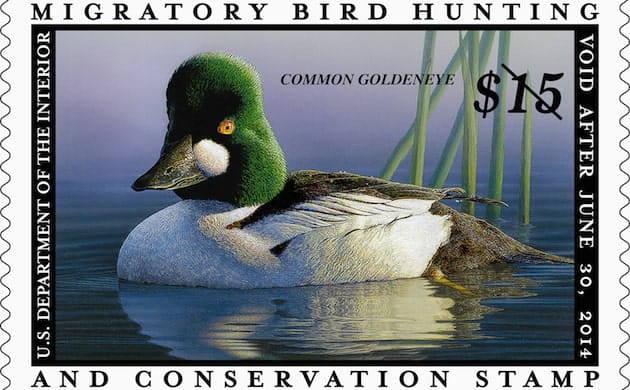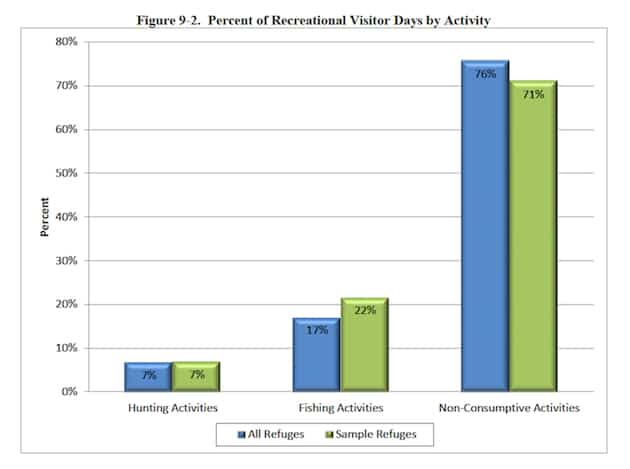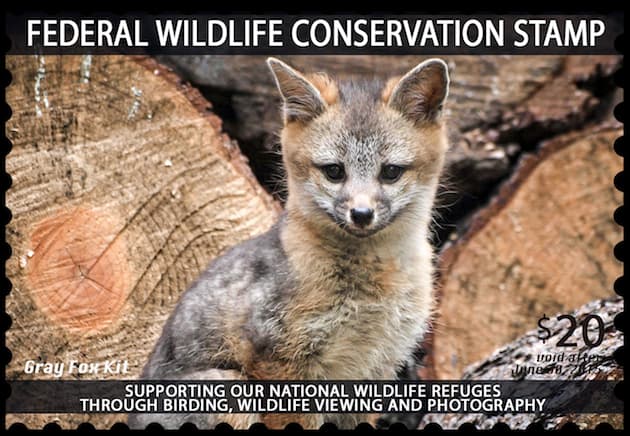The National Wildlife Refuge system is one of America’s greatest treasures. It preserves habitat, protects wildlife. and provides diverse nature experiences for visitors from around the world.
According to the latest (2013) report by the U.S. Fish & Wildlife Service (USFWS) entitled “Banking on Nature: The Economic Benefits to Local Communities of National Wildlife Refuge Visitation,” recreational visits to national wildlife refuges generate substantial economic activity.

In Fiscal Year 2011:
-
46.5 million people visited refuges. Their spending generated $2.4 billion of sales in regional economies. As this spending flowed through the economy, over 35,000 people were employed and $792.7 million in employment income was generated.
-
ABOUT 72 PERCENT OF TOTAL EXPENDITURES ARE GENERATED BY NON-CONSUMPTIVE ACTIVITIES ON REFUGES
.
Fishing accounted for 21 percent and hunting 7 percent. Local residents accounted for 23 percent of expenditures while visitors coming from outside the local area accounted for 77 percent.
-
Refuge recreational spending generated about $342.9 million in tax revenue at the local, county, state and Federal level.
Coinciding with these figures is something we have suspected for a long time, the majority of Recreational Visitor Days are attributable to non-consumptive activities, followed by fishing activities and hunting activities.

Due to some erroneous numbers thrown about by Duck Stamp advocates, I feel that some explanations are in order.
Funds for National Wildlife Refuge land acquisition come from several sources. Congress appropriates these monies primarily with funding from the Land and Water Conservation Fund (LWCF) and the Migratory Bird Conservation Fund (MBCF).
The LWCF receives money from: tax on motorboat fuels, sale of surplus Federal real property, and 3) Outer Continental Shelf oil and gas leasing fees.
The MBCF receives money from: sale of Duck Stamps, import duties on firearms and ammunition (not excise taxes which are paid to the states for wildlife and habitat management), appropriations from the General Fund, right-of-way permit and/or easement fees and the sale of surplus refuge lands, any monies remaining after refuge revenue sharing payments have been made to the counties each Fiscal Year, and any Federal Aid monies that are unexpended by a state each Fiscal Year. Collectively, these MBCF funds have purchased about 2.7 million acres or about 3% of refuge land2. To be clear, Duck Stamp proceeds make up only a portion of the 3% of refuge land purchased by the MBCF.
Now, as the popularity of hunting has declined, so too have the sales of Duck Stamps. In 1972 the greatest number of stamps were sold at over 2.4 million. In 2011 that number has decreased to 1.5 million, a 37% reduction3.
Because of these declines, there has been a recent push to encourage birders and other non-consumptive users to buy the Duck Stamp; however, these programs face some understandable resistance. They don’t take into account the valid concerns non-hunters have about buying the stamp, which fall into two main areas:
1. Many wildlife watchers, birders and photographers don’t want to support a stamp that is so intimately and historically associated with hunting.
2. Duck Stamp sales to non-hunters are not accurately calculated to reflect their contributions – which tends to short change the conservation goals of non-consumptive users.
Case in point. On March 5, 2014, the U.S. Fish and Wildlife Service Director Dan Ashe announced the agency will expand hunting and fishing opportunities throughout the National Wildlife Refuge System, opening up new hunting programs on six refuges and expanding existing hunting and fishing programs on another 20 refuges. The rule also modifies existing refuge-specific regulations for more than 75 additional refuges and wetland management districts4.
Is it just me, or does this make no sense?
With all the talk about loss of revenue from the dwindling number of waterfowl hunters, you would think that the U.S. Fish & Wildlife Service would be ecstatic about the growing number of wildlife watchers and non-consumptive users of the National Wildlife Refuges. You would think they would look at these numbers and try to figure out a way to tap into that huge demographic right?
They haven’t, but we have. We have a very simple solution.
Create a second fund-raising stamp for wildlife watchers. A new stamp that says to all non-consumptive users, “You matter, your choices matter, your conservation priorities matter.”
A new stamp that establishes an unambiguous revenue stream for our National Wildlife Refuges while resonating with the values and ethics of the non-hunting community.
A Wildlife Conservation Stamp!

Is this idea so difficult to grasp? From the comments we have received over the last year there are thousands of birders, wildlife photographers and others that think this is a great solution to a simple problem. Create a more appealing alternative for non-consumptive users of our refuge system and give people a choice.
There is no competition here. Simply an alternative. An additional choice. One that would obviously be the only choice for some conservationists who want to directly support our National Wildlife Refuge System.
I have yet to hear one substantial argument opposing this proposal. There is just no downside to offering the overwhelming majority of refuge visitors an additional choice. It’s a no-brainer.
Support creation of a Wildlife Conservation Stamp. If you are an individual wanting to support this proposal, check out our “About Us” page and fill out the submission form at the bottom of the page. If you are an organization wanting to add your support, check out our “Organizations In Support” page and fill out the form at the bottom of that page. You can also show your support by liking our Facebook page and following us on Twitter!
References: 1US Fish & Wildlife Service, 2US Fish & Wildlife Service, 3US Fish & Wildlife Service, 4US Fish & Wildlife Service
Larry Jordan
Larry Jordan is an avid birder and amateur photographer living on the Pacific Flyway near the Central Valley of Northern California. He is a board member of his local Audubon Society and is a bird and wildlife conservationist. Larry contributes to several wildlife conservation organizations and is a BirdLife International "Species Champion." He is also Habitat Manager for the Burrowing Owl Conservation Network, an organization dedicated to the protection and restoration of the Western Burrowing Owl population in the United States. Larry has been blogging about birds since September of 2007 at TheBirdersReport.com
Leave a Reply